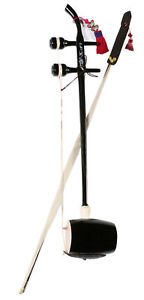Back to the main page Back to category Erhus
musical instrument details
KOREAN STRING INSTRUMENT "ERHU" "HAEGEUM" HAEGUM_HAEKEUM
Estimated price for orientation: 699 $
Category: Erhus
Class:
Description Condition: New: A brand-new, unused, unopened, undamaged item in its original packaging (where packaging is applicable). Packaging should be the same as what is found in a retail store, unless the item is handmade or was packaged by the manufacturer in non-retail packaging, such as an unprinted box or plastic bag. See the seller's listing for full details. See all condition definitions- opens in a new window or tab ... Read moreabout the condition Country of Manufacture: Korea, Republic of MPN: Does Not Apply Brand: Unbranded UPC: Does not apply
Traditional Korean Musical Instrument :: Geum Bu (Metal instrument) Teukjong is a large bell hung on the frame and is played by striking it. This instrument was made by the great musician Park Yeon during the reign of King Sejong as he arranged the royal court music. It signaled the beginning of ceremonial music Pyeonjong is a set of 16 small bells with the same size hung on the frame and is played by striking it with an ox hornmallet. This instrument was imparted from the Chinese Sung Dynasty during the Goryeo Dynasty period and was improved by the great musician Park Yeon. The thicker the bells are, the higher pitch sound they give. Banghyang is made of two rows of 16palm-size metal plates like the pyeongjong and is played by striking it with an ox horm mallet. It is also called cheolhyang, and the thicker the metal is, the higher sound it emits. Yanggeum Compared to the fact that other string instruments are made of silk threads, the yanggeum is made of 56 metal strings that give off clear metal sounds. This instrument is made by setting up two bars on a lozenge-shape box and placing metal strings between them. It is played by striking it with a bamboo stick. Jing According to the size, jings are referred to as jeong, geumjeong, geum, geumna, and na. They are played by striking it with a stick with the cloth-wrapped end, thus giving off a solemn, soft and long-echoing sound Kkwaenggwari also referred to as the sogeum and kkwaengmaegi, is played by striking it with a wooden stick with the handle made of string like jing. It was used to produce music for royal court ceremonies. Recently, the kkwaenggwari is played mainly to create farmer`s music and court dance music. Nabal is a wind instrument that gives off a metallic and majestic sound. It is made by molding metal into a long pipe, which gets thinner towards the blowhole and thicker toward the trumpet flower-shaped end. Jabara is also referred to as bara, bal, and jegeum. Jabara consists of a pair of two cooker cover-shaped thin and circular brass plates with holes punched on the center to insert strings through them to make handles. To play the instrument, the two plates are held by the string and hit with each other. Ulla is a set of 10-tune dish-shaped small copper gongs hung on the frame and is played by striking it with a small mallet. It gives off a clear sound similar to that of a xylophonel and is used to give off creative traditional Korean notes. Traditional Korean Musical Instrument :: Sa Bu(string instrument) Geomungo To make the sounding case, the front board made of paulownia tree is attached to the back board made of chestnut tree. Sit strings of twisted sklk threads are placed an the case to complete a geonumgo. It is played with a bamboo stick and gives the broadest sound among all traditional Korean instruments. Gayageum This 12-string gayageum is made of the same materials as the geomungo. It is categorized into classic gayageum and folk music gayageum and is played by the left hand pressing the strings and the right hand plucking or plunking them. Daejaeng As a 15-string instrument, daejaeng is similar to the gayageum in shape, but is more majestic in terms of tone color.
It is played by the left han
Description
| Condition: | New: A brand-new, unused, unopened, undamaged item in its original packaging (where packaging is applicable). Packaging should be the same as what is found in a retail store, unless the item is handmade or was packaged by the manufacturer in non-retail packaging, such as an unprinted box or plastic bag. See the seller's listing for full details. See all condition definitions- opens in a new window or tab ... Read moreabout the condition | Country of Manufacture: | Korea, Republic of |
| MPN: | Does Not Apply | Brand: | Unbranded |
| UPC: | Does not apply |
It is played by the left han
